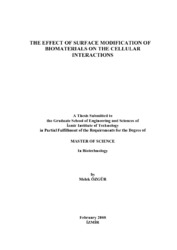Please use this identifier to cite or link to this item:
https://hdl.handle.net/11147/4017| Title: | The effect of surface modification of biomaterials on the cellular interactions | Authors: | Özgür, Melek | Advisors: | Çiftçioğlu, Muhsin | Publisher: | Izmir Institute of Technology | Abstract: | The preparation and characterization of chitosan-hydroxyapatite composite scaffolds and protein adsorption chracteristics of these scaffolds have been investigated in this study. The effects of different chitosan/hydroxyapatite contents of the low density composites on the protein adsorption behaviour were experimentally examined.Bradford method at 595 nm and 280 nm UV protein absorption methods were used for the determination of adsorbed amount of bovine serum albumin (BSA) and human serum protein (HSP). In this study low molecular weight chitosan and hydroxyapatite have been used for the preparation of the scaffold composites by freeze drying and SEM was used for microstructural analysis. The thermal behaviour of the composites was investigated by DSC and TGA. Composite scaffolds were prepared by using different amounts of chitosan and hydroxyapatite (HA) and six different scaffolds were prepared and coded as C100H0, C80H20, C70H30, C50H50, C30H70, and C20H80. The porous low density scaffolds had 93.5-96.3% porosity with a slight increase in density with increasing HA content. The interconnected pore network was formed from 50-250 .m relatively uniform size pores with thin pore walls. The HA particles were fully embedded in the polymer matrix in the pore walls. The TGA curves have shown that the freeze dried phase seperation induced biopolymer sturucture degrates at lower temperatures faster than the original raw polymer. The adsorptions of BSA and HSP onto composites have been studied as a function of time, protein concentration and pH. Adsorption experiments were also conducted with commercial HA powder. The adsorption kinetics experiments have indicated that protein adsorption was almost completely achieved in the first 2-3 hours with relatively high uptake values of up to 45-60 mg/g and 40-60 mg/g for 595 nm Bradford and 280 nm methods. The adsorption behaviour did not fit to the commonly known Langmuir and Freundlich isotherms. This was attributed to the swelling/degradation tendency of the freeze-dried chitosan containing scaffolds. The HSP uptake of 30 and 50 wt% HA containing composites were in the 50-60 mg/g range which was higher than other composites and the raw unprocessed chitosan. | Description: | Thesis (Master)--Izmir Institute of Technology, Biotechnology, Izmir, 2008 Includes bibliographical references (leaves: 66-68) Text in English; Abstract: Turkish and English xi, 69 leaves |
URI: | http://hdl.handle.net/11147/4017 |
| Appears in Collections: | Master Degree / Yüksek Lisans Tezleri |
Files in This Item:
| File | Description | Size | Format | |
|---|---|---|---|---|
| T000722.pdf | MasterThesis | 6.05 MB | Adobe PDF |  View/Open |
CORE Recommender
Page view(s)
162
checked on Nov 18, 2024
Download(s)
60
checked on Nov 18, 2024
Google ScholarTM
Check
Items in GCRIS Repository are protected by copyright, with all rights reserved, unless otherwise indicated.